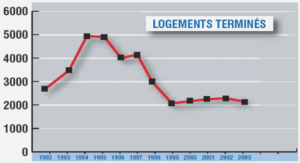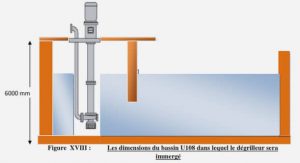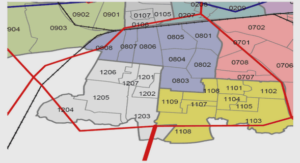PIEGES A PARTICULES ET ESTIMATION DE LA PRODUCTION EXPORTEE EN MER DE BARENTS
Hydrography
The main water masses encountered along the transect are identified with the temperature section (Fig. 2). Atlantic water was predominant in the south and in the center of the section. It was divided in two branches which penetrated the Barents Sea from the South-West. The South Barents Atlantic-derived Water (SBAW), which was relatively warmer (4-7°C) and less dense (27.5-28 t) and the North Barents Atlantic-derived Water (NBAW) where temperature ranged from 2 to 4°C.
On the Sentralbanken, a specific water mass (Sentralbanken Water i.e. SW) of Arctic origin, was isolated between the SBAW and the NBAW with a temperature lower than 2°C. The NBAW reached the MIZ at about 76.5°N. At this latitude, a strong temperature gradient was observed in the entire water column corresponding to the Polar Front and the start of the ice coverage. In the northern part of the transect, Arctic water (AW) was present with temperatures lower than 0°C and salinities less than 34 psu in the upper layer due to ice melting.
Nutrients
The distribution of nitrate followed the hydrographic features described above (Fig. 3). In the upper layer (0-50 m) of Atlantic water, a clear depletion of nutrients was observed. This depletion was deep south and north of Sentralbanken. In deeper waters, nitrate concentrations were higher. Between 75°N and 76°N, the decrease of nutrients reflects the presence of NBAW. Beyond 77°N, the presence of ice in Arctic water prevents a strong depletion of nutrients (light limitation).
The surface nutrient concentrations were lower than during early spring, implying that we were in bloom conditions. Previous cruises along the same transect and modeling work, showed that the spring bloom in the MIZ takes place in April/May and May/June in the central Barents Sea (Wassmann et al., 1999). Laurent Coppola et al. / The Barents Sea 54 3.3 234Th activities 234Th activities and POC concentrations are listed in Table 1 and depth profiles of 234Th are shown in Figure 4. Uranium 238 activities were calculated from salinity using the relationship 238U(dpm/l) = 0.071×S(‰) (Chen et al., 1986). When total 234Th activity (the sum of dissolved and particulate activities) in samples display values close to 238U activity, this indicates that total 234Th is in radioactive equilibrium with 238U.
Deviations from this equilibrium can reflect both scavenging or mineralization (Coale and Bruland, 1987). In the present study, 234Th/238U disequilibria are observed at all locations. However, 234Th activities vary along the transect. At the northern stations (1, 2, 3), total 234Th activities decrease between 0 and 50 m. The 50 m minimum is mostly pronounced at station 1.
At these 3 stations, total 234Th activities increase at depth without reaching equilibrium. At the southern stations, the largest disequilibrium are observed at the surface and the total 234Th activities increase with depth (it slightly exceeds equilibrium at station 4). The particulate 234Th activities are low at the surface of stations 1 and 2 and slightly increase towards bottom. At stations 3, 4 and 5 there is a maximum of particles at the surface and lower values at depth.
Trapped material
During this cruise, 234Th fluxes were measured in the deepest trap (90-200m). The 234Th flux range from 1814 to 4713 dpm m-2 d-1 (Table 3). 234Th fluxes were lower in Arctic water than in Atlantic water. The lowest flux was recorded in the Polar Front area (station 3).




